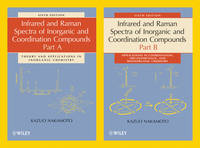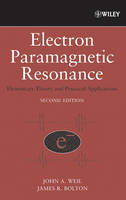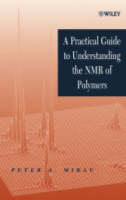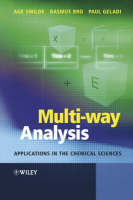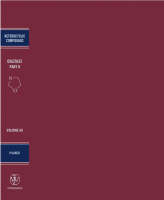Multidimensional Liquid Chromatography
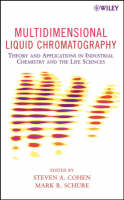 -15%
portes grátis
-15%
portes grátis
Multidimensional Liquid Chromatography
Theory and Applications in Industrial Chemistry and the Life Sciences
Cohen, Steven A.; Schure, Mark R.
John Wiley & Sons Inc
04/2008
492
Dura
Inglês
9780471738473
15 a 20 dias
882
Preface xv
Contributors xvii
1 Introduction 1
1.1 Previous Literature Which Covers MDLC 4
1.2 How this Book is Organized 5
References 6
Part I Theory 9
2 Elements of the Theory of Multidimensional Liquid Chromatography 11
2.1 Introduction 11
2.2 Peak Capacity 13
2.3 Resolution 17
2.4 Orthogonality 19
2.5 Two-Dimensional Theory of Peak Overlap 21
2.6 Dimensionality, Peak Ordering, and Clustering 23
2.7 Theory of Zone Sampling 24
2.8 Dilution and Limit of Detection 26
2.9 Chemometric Analysis 27
2.10 Future Directions 28
References 30
3 Peak Capacity in Two-Dimensional Liquid Chromatography 35
3.1 Introduction 35
3.2 Theory 37
3.3 Procedures 41
3.4 Results and Discussion 42
3.5 Conclusions 49
Appendix 3A Generation of Random Correlated Coordinates 50
Appendix 3B Derivation of Limiting Correlation Coefficient r 54
References 56
4 Decoding Complex 2D Separations 59
4.1 Introduction 59
4.2 Fundamentals: The Statistical Description of Complex Multicomponent Separations 62
4.3 Decoding 1D and 2D Multicomponent Separations by Using the SMO Poisson Statistics 68
4.4 Decoding Multicomponent Separations by the Autocovariance Function 74
4.5 Application to 2D Separations 78
4.5.1 Results from SMO Method 81
4.5.2 Results from 2D Autocovariance Function Method 84
4.6 Concluding Remarks 88
Acknowledgments 88
References 88
Part II Columns, Instrumentation and Methods Development 91
5 Instrumentation for Comprehensive Multidimensional Liquid Chromatography 93
5.1 Introduction 93
5.2 Heart-Cutting Versus Comprehensive Mode 95
5.3 Chromatographic Hardware 97
5.3.1 Valves 97
5.4 CE Interfaces 104
5.4.1 Gated Interface for HPLC-CE 104
5.4.2 Microfluidic Valves for On-Chip Multidimensional Analysis 105
5.5 Columns and Combinations 106
5.5.1 Column Systems, Dilution, and Splitting 108
5.6 Detection 109
5.7 Computer Hardware and Software 109
5.7.1 Software Development 110
5.7.2 Valve Sequencing 111
5.7.3 Data Format and Storage 113
5.8 Zone Visualization 115
5.8.1 Contour Visualization 115
5.8.2 2D Peak Presentation 117
5.8.3 Zone Visualization in Specific Chemical (pI) Regions 117
5.8.4 External Plotting Programs 117
5.8.5 Difference Plots 118
5.8.6 Multi-channel Data 118
5.9 Data Analysis and Signal Processing 119
5.10 Future Prospects 120
References 121
6 Method Development in Comprehensive Multidimensional Liquid Chromatography 127
6.1 Introduction 127
6.2 Previous Work 128
6.3 Column Variables 130
6.4 Method Development 130
6.4.1 The Cardinal Rules of 2DLC Method Development 132
6.5 Planning the Experiment 143
6.6 General Comments on Optimizing the 2DLC Experiment: Speed-Resolution Trade-off 143
Acknowledgment 144
References 144
7 Monolithic Columns and Their 2D-HPLC Applications 147
7.1 Introduction 147
7.2 Monolithic Polymer Columns 148
7.2.1 Structural Properties of Polymer Monoliths 148
7.2.2 Chromatographic Properties of Polymer Monolithic Columns 150
7.2.3 Two-Dimensional HPLC Using Polymer Monoliths 152
7.3 Monolithic Silica Columns 153
7.3.1 Preparation 154
7.3.2 Structural Properties of Monolithic Silica Columns 154
7.3.3 Chromatographic Properties of Monolithic Silica Columns 156
7.4 Peak Capacity Increase by Using Monolithic Silica Columns in Gradient Elution 158
7.5 2D HPLC Using Monolithic Silica Columns 159
7.5.1 RP-RP 2D HPLC Using Two Different Columns 161
7.5.2 RP-RP 2D HPLC Using Two Similar Columns 164
7.5.3 Ion Exchange-Reversed-Phase 2D HPLC Using a Monolithic Column for the 2nd-D 166
7.5.4 IEX-RP 2D HPLC Using a Monolithic RP Capillary Column for the 2nd-D 168
7.6 Summary and Future Improvement of 2D HPLC 171
References 171
8 Ultrahigh Pressure Multidimensional Liquid Chromatography 177
8.1 Background: MDLC in the Jorgenson Lab 177
8.1.1 Cation Exchange-Size Exclusion 178
8.1.2 Anion Exchange-Reversed Phase 180
8.1.3 Cation Exchange-Reversed Phase 181
8.1.4 Size Exclusion-Reversed Phase 183
8.2 Online Versus Off-Line MDLC 188
8.3 MDLC Using Ultrahigh Pressure Liquid Chromatography: Benefits and Challenges 189
8.3.1 An Introduction to UHPLC 190
8.3.2 UHPLC for LC LC: High Speed Versus High Peak Capacity 191
8.3.3 LC UHPLC for Separations of Intact Proteins 191
8.4 Experimental Details 193
8.4.1 Instrumentation 193
8.4.2 Data Analysis 194
8.4.3 Chromatographic Conditions 195
8.4.4 Samples 196
8.5 Results and Discussion 196
8.6 Future Directions for UHP-MDLC 202
References 203
Part III Life Science Applications 205
9 Peptidomics 207
9.1 State of the Art-Why Peptidomics? 207
9.2 Strategies and Solutions 208
9.3 Summary and Conclusions 218
References 218
10 A Two-Dimensional Liquid Mass Mapping Technique for Biomarker Discovery 221
10.1 Introduction 221
10.2 Methods for Separating and Identifying Proteins 223
10.2.1 pI-Based Methods of Separation 223
10.2.2 Chromatofocusing-A Column Based pH Separation 225
10.2.3 Nonporous Separation of Proteins 226
10.2.4 Electrospray-Time of Flight-Mass Spectrometry 228
10.2.5 MALDI Peptide Mass Fingerprinting 229
10.2.6 Data Analysis and Recombination 230
10.3 Applications 230
10.3.1 Proteomic Mapping and Clustering of Multiple Samples-Application to Ovarian Cancer Cell Lines 230
10.3.2 2D Liquid Mass Mapping of Tumor Cell Line Secreted Samples, Application to Metastasis-Associated Protein Profiles 233
10.3.3 Identification Annotation and Data Correlation in MCF10 Human Breast Cancer Cell Lines 235
10.4 Summary and Conclusions 237
Acknowledgments 238
References 238
11 Coupled Multidimensional Chromatography and Tandem Mass Spectrometry Systems for Complex Peptide Mixture Analysis 243
11.1 Scx-rp/ms/ms 245
11.2 Scx/rp/ms/ms 248
11.3 MudPIT 251
11.4 Alternative First Dimension Approaches 254
11.5 Conclusion 255
References 255
12 Development of Orthogonal 2DLC Methods for Separation of Peptides 261
12.1 Introduction 261
12.2 Previous Work 263
12.3 Developing Orthogonal 2DLC Methods 264
12.3.1 LC Selectivity for Peptides: Experimental Design 264
12.3.2 Investigation of 2DLC Orthogonality for Separation of Peptides 266
12.3.3 Geometric Approach to Orthogonality in 2DLC 271
12.3.4 Practical 2DLC Considerations in Proteome Research 275
12.3.5 Evaluation of Selected 2DLC MS/MS Systems 276
12.3.6 Peak Capacity in 2DLC-MS/MS 280
12.3.7 Considerations of Concentration Dynamic Range 282
12.4 Conclusions 284
Acknowledgment 284
References 284
13 Multidimensional Separation of Proteins with Online Electrospray Time-of-Flight Mass Spectrometric Detection 291
13.1 Introduction 291
13.2 Chromatographic Parameters 293
13.3 Analyte Detection and Subsequent Analysis 293
13.4 Building a Multidimensional Protein Separation 294
13.4.1 Selection of an Ion-Exchange-Reversed-Phase Separation System for Protein-Level Separations 295
13.4.2 Chromatographic Sorbent Considerations 295
13.4.3 Chromatographic Behavior of Proteins 296
13.5 Comprehensive Multidimensional Chromatographic Systems 296
13.6 Coupling 2DLC with Online ESI-MS Detection 299
13.6.1 Interactions between the Two Dimensions of Chromatography (Step Vs. Linear) 304
13.6.2 Recognizing Increased Selectivity in 2DLC Separations 306
13.7 Expanding Multidimensional Separations into a "Middle-Out" Approach to Proteomic Analysis 308
13.8 Future Directions in Protein MDLC 311
13.8.1 Protein Chromatography 312
13.8.2 MS Analysis of Proteins 313
13.8.3 Data Interpretation 314
13.9 Conclusion 314
References 315
14 Analysis of Enantiomeric Compounds Using Multidimensional Liquid Chromatography 319
14.1 Online Achiral-Chiral LC-LC 320
14.2 Applications 323
14.2.1 Analysis of Enantiomers in Plasma and Urine 323
14.3 Amino Acids 328
14.3.1 Physiological Fluids or Tissues 328
14.3.2 In Food, Beverages, and Other Products 333
14.4 Other Applications 334
14.4.1 Analysis of Enantiomers from Plant and Environmental Sources 334
14.5 Miscellaneous Applications 336
14.6 Conclusion 338
References 339
Part IV Multidimensional Separation Using Capillary Electrophoresis 345
15 Two-Dimensional Capillary Electrophoresis for the Comprehensive Analysis of Complex Protein Mixtures 347
15.1 Introduction 347
15.2 Previous Work 348
15.2.1 Miniaturized IEF/SDS-PAGE 348
15.2.2 One-Dimensional Capillary Electrophoresis for Protein Analysis 349
15.3 Two-Dimensional Capillary Separations for Analysis of Peptides and Proteins 352
15.3.1 Capillary Liquid Chromatography Coupled with Capillary Electrophoresis for Analysis of Unlabeled Peptides and Proteins 352
15.3.2 Two-Dimensional Capillary Electrophoresis for Analysis of Proteins 352
15.3.3 High-Speed Two-Dimensional Capillary Electrophoresis 356
15.3.4 The Analysis of a Single Fixed Cell 358
15.4 Conclusions 360
15.5 Abbreviations 360
References 360
16 Two-Dimensional HPLC-CE Methods for Protein/Peptide Separation 365
16.1 Introduction 365
16.2 Off-line Versus Online 366
16.3 HPLC Fractionation 366
16.4 2d Hplc-ce 367
16.5 CE-MS Detection 368
16.6 Applications 370
16.7 Concluding Remarks 380
Acknowledgment 381
References 381
Part V Industrial Applications 385
17 Multidimensional Liquid Chromatography in Industrial Applications 387
17.1 Introduction 387
17.2 Principles of Multidimensional Liquid Chromatography as Applied to Polymer Analysis 390
17.3 Experimental 393
17.4 Analysis of Alkylene Oxide-Based Polymers 395
17.4.1 Amphiphilic Polyalkylene Oxides 395
17.5 Excipients 399
17.6 Polyether Polyols 403
17.7 Analysis of Condensation Polymers 406
17.8 Polyamides 407
17.9 Aromatic Polyesters 414
17.10 Aliphatic Polyesters 417
References 420
18 The Analysis of Surfactants by Multidimensional Liquid Chromatography 425
18.1 Introduction 425
18.2 Analytical Characterization Methods 428
18.2.1 CE and CGE 429
18.2.2 Sec 430
18.2.3 Nplc 431
18.2.4 Rplc 433
18.3 Detection Methods 434
18.4 2dlc 434
18.4.1 RPLC Coupled to SEC 435
18.4.2 NPLC Coupled to RPLC 435
18.5 Conclusions 442
References 443
Index 447
Preface xv
Contributors xvii
1 Introduction 1
1.1 Previous Literature Which Covers MDLC 4
1.2 How this Book is Organized 5
References 6
Part I Theory 9
2 Elements of the Theory of Multidimensional Liquid Chromatography 11
2.1 Introduction 11
2.2 Peak Capacity 13
2.3 Resolution 17
2.4 Orthogonality 19
2.5 Two-Dimensional Theory of Peak Overlap 21
2.6 Dimensionality, Peak Ordering, and Clustering 23
2.7 Theory of Zone Sampling 24
2.8 Dilution and Limit of Detection 26
2.9 Chemometric Analysis 27
2.10 Future Directions 28
References 30
3 Peak Capacity in Two-Dimensional Liquid Chromatography 35
3.1 Introduction 35
3.2 Theory 37
3.3 Procedures 41
3.4 Results and Discussion 42
3.5 Conclusions 49
Appendix 3A Generation of Random Correlated Coordinates 50
Appendix 3B Derivation of Limiting Correlation Coefficient r 54
References 56
4 Decoding Complex 2D Separations 59
4.1 Introduction 59
4.2 Fundamentals: The Statistical Description of Complex Multicomponent Separations 62
4.3 Decoding 1D and 2D Multicomponent Separations by Using the SMO Poisson Statistics 68
4.4 Decoding Multicomponent Separations by the Autocovariance Function 74
4.5 Application to 2D Separations 78
4.5.1 Results from SMO Method 81
4.5.2 Results from 2D Autocovariance Function Method 84
4.6 Concluding Remarks 88
Acknowledgments 88
References 88
Part II Columns, Instrumentation and Methods Development 91
5 Instrumentation for Comprehensive Multidimensional Liquid Chromatography 93
5.1 Introduction 93
5.2 Heart-Cutting Versus Comprehensive Mode 95
5.3 Chromatographic Hardware 97
5.3.1 Valves 97
5.4 CE Interfaces 104
5.4.1 Gated Interface for HPLC-CE 104
5.4.2 Microfluidic Valves for On-Chip Multidimensional Analysis 105
5.5 Columns and Combinations 106
5.5.1 Column Systems, Dilution, and Splitting 108
5.6 Detection 109
5.7 Computer Hardware and Software 109
5.7.1 Software Development 110
5.7.2 Valve Sequencing 111
5.7.3 Data Format and Storage 113
5.8 Zone Visualization 115
5.8.1 Contour Visualization 115
5.8.2 2D Peak Presentation 117
5.8.3 Zone Visualization in Specific Chemical (pI) Regions 117
5.8.4 External Plotting Programs 117
5.8.5 Difference Plots 118
5.8.6 Multi-channel Data 118
5.9 Data Analysis and Signal Processing 119
5.10 Future Prospects 120
References 121
6 Method Development in Comprehensive Multidimensional Liquid Chromatography 127
6.1 Introduction 127
6.2 Previous Work 128
6.3 Column Variables 130
6.4 Method Development 130
6.4.1 The Cardinal Rules of 2DLC Method Development 132
6.5 Planning the Experiment 143
6.6 General Comments on Optimizing the 2DLC Experiment: Speed-Resolution Trade-off 143
Acknowledgment 144
References 144
7 Monolithic Columns and Their 2D-HPLC Applications 147
7.1 Introduction 147
7.2 Monolithic Polymer Columns 148
7.2.1 Structural Properties of Polymer Monoliths 148
7.2.2 Chromatographic Properties of Polymer Monolithic Columns 150
7.2.3 Two-Dimensional HPLC Using Polymer Monoliths 152
7.3 Monolithic Silica Columns 153
7.3.1 Preparation 154
7.3.2 Structural Properties of Monolithic Silica Columns 154
7.3.3 Chromatographic Properties of Monolithic Silica Columns 156
7.4 Peak Capacity Increase by Using Monolithic Silica Columns in Gradient Elution 158
7.5 2D HPLC Using Monolithic Silica Columns 159
7.5.1 RP-RP 2D HPLC Using Two Different Columns 161
7.5.2 RP-RP 2D HPLC Using Two Similar Columns 164
7.5.3 Ion Exchange-Reversed-Phase 2D HPLC Using a Monolithic Column for the 2nd-D 166
7.5.4 IEX-RP 2D HPLC Using a Monolithic RP Capillary Column for the 2nd-D 168
7.6 Summary and Future Improvement of 2D HPLC 171
References 171
8 Ultrahigh Pressure Multidimensional Liquid Chromatography 177
8.1 Background: MDLC in the Jorgenson Lab 177
8.1.1 Cation Exchange-Size Exclusion 178
8.1.2 Anion Exchange-Reversed Phase 180
8.1.3 Cation Exchange-Reversed Phase 181
8.1.4 Size Exclusion-Reversed Phase 183
8.2 Online Versus Off-Line MDLC 188
8.3 MDLC Using Ultrahigh Pressure Liquid Chromatography: Benefits and Challenges 189
8.3.1 An Introduction to UHPLC 190
8.3.2 UHPLC for LC LC: High Speed Versus High Peak Capacity 191
8.3.3 LC UHPLC for Separations of Intact Proteins 191
8.4 Experimental Details 193
8.4.1 Instrumentation 193
8.4.2 Data Analysis 194
8.4.3 Chromatographic Conditions 195
8.4.4 Samples 196
8.5 Results and Discussion 196
8.6 Future Directions for UHP-MDLC 202
References 203
Part III Life Science Applications 205
9 Peptidomics 207
9.1 State of the Art-Why Peptidomics? 207
9.2 Strategies and Solutions 208
9.3 Summary and Conclusions 218
References 218
10 A Two-Dimensional Liquid Mass Mapping Technique for Biomarker Discovery 221
10.1 Introduction 221
10.2 Methods for Separating and Identifying Proteins 223
10.2.1 pI-Based Methods of Separation 223
10.2.2 Chromatofocusing-A Column Based pH Separation 225
10.2.3 Nonporous Separation of Proteins 226
10.2.4 Electrospray-Time of Flight-Mass Spectrometry 228
10.2.5 MALDI Peptide Mass Fingerprinting 229
10.2.6 Data Analysis and Recombination 230
10.3 Applications 230
10.3.1 Proteomic Mapping and Clustering of Multiple Samples-Application to Ovarian Cancer Cell Lines 230
10.3.2 2D Liquid Mass Mapping of Tumor Cell Line Secreted Samples, Application to Metastasis-Associated Protein Profiles 233
10.3.3 Identification Annotation and Data Correlation in MCF10 Human Breast Cancer Cell Lines 235
10.4 Summary and Conclusions 237
Acknowledgments 238
References 238
11 Coupled Multidimensional Chromatography and Tandem Mass Spectrometry Systems for Complex Peptide Mixture Analysis 243
11.1 Scx-rp/ms/ms 245
11.2 Scx/rp/ms/ms 248
11.3 MudPIT 251
11.4 Alternative First Dimension Approaches 254
11.5 Conclusion 255
References 255
12 Development of Orthogonal 2DLC Methods for Separation of Peptides 261
12.1 Introduction 261
12.2 Previous Work 263
12.3 Developing Orthogonal 2DLC Methods 264
12.3.1 LC Selectivity for Peptides: Experimental Design 264
12.3.2 Investigation of 2DLC Orthogonality for Separation of Peptides 266
12.3.3 Geometric Approach to Orthogonality in 2DLC 271
12.3.4 Practical 2DLC Considerations in Proteome Research 275
12.3.5 Evaluation of Selected 2DLC MS/MS Systems 276
12.3.6 Peak Capacity in 2DLC-MS/MS 280
12.3.7 Considerations of Concentration Dynamic Range 282
12.4 Conclusions 284
Acknowledgment 284
References 284
13 Multidimensional Separation of Proteins with Online Electrospray Time-of-Flight Mass Spectrometric Detection 291
13.1 Introduction 291
13.2 Chromatographic Parameters 293
13.3 Analyte Detection and Subsequent Analysis 293
13.4 Building a Multidimensional Protein Separation 294
13.4.1 Selection of an Ion-Exchange-Reversed-Phase Separation System for Protein-Level Separations 295
13.4.2 Chromatographic Sorbent Considerations 295
13.4.3 Chromatographic Behavior of Proteins 296
13.5 Comprehensive Multidimensional Chromatographic Systems 296
13.6 Coupling 2DLC with Online ESI-MS Detection 299
13.6.1 Interactions between the Two Dimensions of Chromatography (Step Vs. Linear) 304
13.6.2 Recognizing Increased Selectivity in 2DLC Separations 306
13.7 Expanding Multidimensional Separations into a "Middle-Out" Approach to Proteomic Analysis 308
13.8 Future Directions in Protein MDLC 311
13.8.1 Protein Chromatography 312
13.8.2 MS Analysis of Proteins 313
13.8.3 Data Interpretation 314
13.9 Conclusion 314
References 315
14 Analysis of Enantiomeric Compounds Using Multidimensional Liquid Chromatography 319
14.1 Online Achiral-Chiral LC-LC 320
14.2 Applications 323
14.2.1 Analysis of Enantiomers in Plasma and Urine 323
14.3 Amino Acids 328
14.3.1 Physiological Fluids or Tissues 328
14.3.2 In Food, Beverages, and Other Products 333
14.4 Other Applications 334
14.4.1 Analysis of Enantiomers from Plant and Environmental Sources 334
14.5 Miscellaneous Applications 336
14.6 Conclusion 338
References 339
Part IV Multidimensional Separation Using Capillary Electrophoresis 345
15 Two-Dimensional Capillary Electrophoresis for the Comprehensive Analysis of Complex Protein Mixtures 347
15.1 Introduction 347
15.2 Previous Work 348
15.2.1 Miniaturized IEF/SDS-PAGE 348
15.2.2 One-Dimensional Capillary Electrophoresis for Protein Analysis 349
15.3 Two-Dimensional Capillary Separations for Analysis of Peptides and Proteins 352
15.3.1 Capillary Liquid Chromatography Coupled with Capillary Electrophoresis for Analysis of Unlabeled Peptides and Proteins 352
15.3.2 Two-Dimensional Capillary Electrophoresis for Analysis of Proteins 352
15.3.3 High-Speed Two-Dimensional Capillary Electrophoresis 356
15.3.4 The Analysis of a Single Fixed Cell 358
15.4 Conclusions 360
15.5 Abbreviations 360
References 360
16 Two-Dimensional HPLC-CE Methods for Protein/Peptide Separation 365
16.1 Introduction 365
16.2 Off-line Versus Online 366
16.3 HPLC Fractionation 366
16.4 2d Hplc-ce 367
16.5 CE-MS Detection 368
16.6 Applications 370
16.7 Concluding Remarks 380
Acknowledgment 381
References 381
Part V Industrial Applications 385
17 Multidimensional Liquid Chromatography in Industrial Applications 387
17.1 Introduction 387
17.2 Principles of Multidimensional Liquid Chromatography as Applied to Polymer Analysis 390
17.3 Experimental 393
17.4 Analysis of Alkylene Oxide-Based Polymers 395
17.4.1 Amphiphilic Polyalkylene Oxides 395
17.5 Excipients 399
17.6 Polyether Polyols 403
17.7 Analysis of Condensation Polymers 406
17.8 Polyamides 407
17.9 Aromatic Polyesters 414
17.10 Aliphatic Polyesters 417
References 420
18 The Analysis of Surfactants by Multidimensional Liquid Chromatography 425
18.1 Introduction 425
18.2 Analytical Characterization Methods 428
18.2.1 CE and CGE 429
18.2.2 Sec 430
18.2.3 Nplc 431
18.2.4 Rplc 433
18.3 Detection Methods 434
18.4 2dlc 434
18.4.1 RPLC Coupled to SEC 435
18.4.2 NPLC Coupled to RPLC 435
18.5 Conclusions 442
References 443
Index 447






